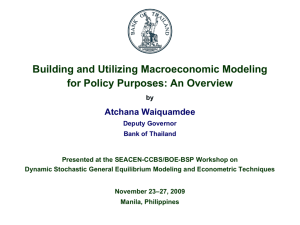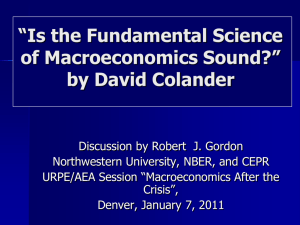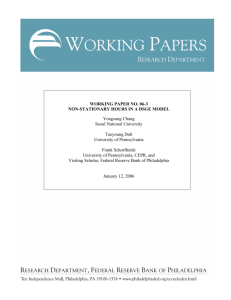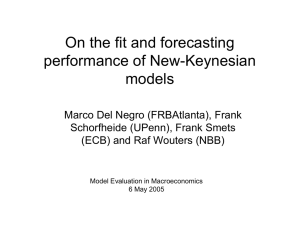Forecasting Performance of an Estimated Open Economy DSGE Model
advertisement
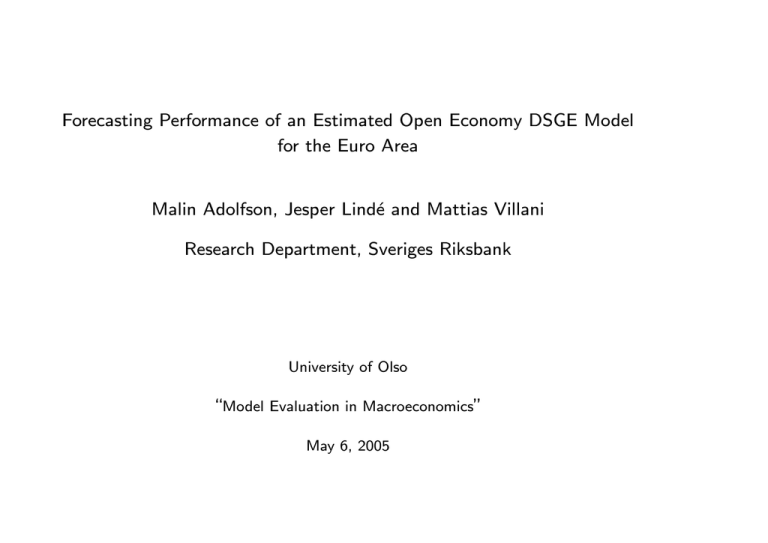
Forecasting Performance of an Estimated Open Economy DSGE Model
for the Euro Area
Malin Adolfson, Jesper Lindé and Mattias Villani
Research Department, Sveriges Riksbank
University of Olso
“Model Evaluation in Macroeconomics”
May 6, 2005
Background
• Trade-Off between theoretical and empirical coherence of macromodels (Pagan, BoE 2003)
— VARs empirically coherent
— Dynamic stochastic general equilibrium (DSGE) models more theoretically coherent
• New generation of DSGE models have shown potential of shrinking
this gap
• Christiano, Eichenbaum and Evans (JPE, 2005) closed economy DSGE
model
— Able to match the dynamic effects of a monetary policy shock in an identified
VAR
• Work of CEE extended by Smets and Wouters (2003, 2004)
— Closed economy DSGE models have forecasting properties in line with VARs and
BVARs
• Important selection criteria for useful models at central banks
— Reasonable monetary transmission mechanism
— Expectations formations important - transparency and credibility matter
— Good “track record”
This paper
• Examine forecasting performance of an open economy DSGE model
• Open economy elements
— Add complexity: more variables, more shocks, transmission of monetary policy
• The open economy DSGE model as a forecasting tool
— Accurate forecasts in general?
— Forecasts for the exchange rate, imports, exports of particular interest
— Look at point forecasts as well as density forecasts
What we have done
• The open economy DSGE model (Adolfson, Laséen, Lindé, Villani,
2004)
— Augmented the CEE closed economy DSGE model with open economy elements
# Consumption and investment baskets
# Incomplete exchange rate pass-through (local currency pricing)
# Stochastic unit-root technology shock (Altig et al., 2003)
• Bayesian estimation following Smets and Wouters (2003, 2004)
— Estimate log-linearized version of the model
• Forecast evaluation for 1994Q1-2002Q4 (Euro area data)
— Extend sample quarterly (re-estimate DSGE yearly)
— Compare with VARs, MLVARs, naı̈ve forecasts (re-estimate quarterly)
Main results
• Open economy DSGE model compares well with various BVARs
• Univariate point forecasts in the DSGE
- Performs well on the real exchange rate, import and export
- Decent on CPI inflation, output, and the interest rate
- Worse on domestic inflation
• Multivariate point forecasts
- DSGE has a slight edge over BVARs at longer horizons (8 quarters)
• Density forecasts and forecast intervals
- DSGE picks up on overall forecast density at longer horizons (LDPS)
- Empirical coverage more balanced for DSGE than BVARs
Remaining of talk
• DSGE Model
• Alternative Models
• Forecasting exercise
• Results
• Conclusions
• Future work
DSGE model overview
• Households
• Firms
i) Domestic firms
ii) Importing firms
• Central bank (Taylor rule)
• Government (exogenous)
• Foreign economy (exogenous)
iii) Exporting firms
Frictions
• Nominal price stickiness; domestic prices, import and export prices
(Calvo)
• Wage stickiness (Calvo)
• Capital adjustment costs (investment)
• Variable capacity utilization
• Habit persistence in consumption
• Working capital channel
• Distorting taxes
Estimated shocks
• Technology shocks (µz,t, ²t), investment specific (Υt), asymmetric
(zet∗)
m,c
• Markup shocks (λdt, λt
m,i
, λt
, λxt)
• Preference shocks (ζ ct, ζ h
t)
e )
• Risk premium shock (φ
t
• Monetary policy shocks (εR,t, π̄ ct)
Household preferences
• Preferences
³
´
Qj,t
j
q
c
ζ t U Cj,t − bCj,t−1 − ζ h
L(h
)
+
ζ
V
(
t
t
t
ztPt )
• Consumption and investment aggregates CES
∙
¸η /(η −1)
´(η −1)/η
c
c
1/η
c
c
(η
−1)/η
1/η
d
m
c
c
c
c
Ct
+ ωc
(Ct )
Ct = (1 − ω c)
∙
¸η /(η −1)
³ ´(η −1)/η
i
i
1/η
i
i
(η
−1)/η
1/η
d
m
i
i
i
It = (1 − ω i) i It
+ ωi
(It )
³
• Consumption demand
∙
´1−η ¸1/(1−η c)
m,c
c
Ptc = (1 − ω c) (Pt)1−ηc + ω c Pt
∙ ¸−η
∙ m,c ¸−η
c
c
Pt
Pt
d
m
Ct = (1 − ω c) P c
Ct, Ct = ω c P c
Ct
t
t
³
Capital and Investment
• Law of motion, physical capital stock
³
´
K̄t+1 = (1 − δ)K̄t + Υt 1 − S̃ (It/It−1) It
00
S̃ (µz ) = S̃ 0 (µz ) = 0, S̃ (µz ) > 0 - investment adjustment costs
b̄
b −k
• Capital utilization rate ût = k
t
t satisfies
k
1
1
τ
k
b −k =
bk
k
rbt −
τ
t
t
σa
σ a (1 − τ k ) t
b̄
Low/High σ a ⇔ Low/High capacity utilization costs
UIP condition
• Assuming imperfect financial integration between domestic and foreign
∗ Φ(a
e
economies, i.e. effective foreign nominal interest rate Rt−1
t−1, φt)
• Combine focs for domestic and foreign bond holdings
b
eb + φ
e
b −R
b ∗ = E ∆S
b
R
t
t
t
t+1 − φa
t
t
Intermediate domestic firms
α H 1−α − z φ
Yi,t = zt1−α²tKi,t
t
i,t
• Production technology (firm i)
— zt permanent technology shock, µz,t = zt/zt−1 and
³
´
µz,t = 1 − ρµz µz + ρµz µz,t−1 + eµz ,t
• — εt stationary technology shock, E(ε) = 1 and
εt = (1 − ρε) + ρεεt−1 + eε,t
• Marginal cost (cost min) mct =
³
´
³ ´ ³ ´ ³
´
1 1−α 1 α r k α w̄ Rf 1−α 1
t t
t
1−α
α
²t
f
— Borrow fraction ν t ∈ (0, 1) to wages, Rt ≡ ν tRt−1 + 1 − ν t
Calvo pricing equations
• Pricing equations
³
j
b̄ c
bt − π
π
t
for j =
n
´
³
´
³
´
κj
β
c
c
j
j
b̄
b̄
b t+1 − ρπ π t +
b t−1 − π t
=
Etπ
π
1 + κj β
1 + κj β
(1 − ξ j )(1 − βξ j ) µ j b j ¶
³
´
dct + λt
+
m
ξ j 1 + κj β
d mc mi x
o
Monetary policy
• Instrument rule (Taylor type)
³
³
´
´
c
c
c
b
b
b̄
b̄
Rt = ρRRt−1 + (1 − ρR) π t + rπ π̂ t−1 − π t + ry ŷt−1 + rxx̂t
+r∆π ∆π̂ ct + r∆y ∆ŷt + εR,t
Estimation
• Estimate 51 parameters
— Price stickiness, technology growth, habit formation, policy rule, persistence and
std of shocks, etc.
— Calibrate parameters not well identified by the time series we match
• Euro area data 1970Q1-2002Q4
• Match large set of variables (facilitate identification of key parameters)
Êt ∆ ln Yt...
[ π dt ∆ ln(Wt/Pt) ∆ ln Ct ∆ ln It
x̂t
Rt
Ỹt =
def,c
def,i
∆ ln X̃t
∆ ln M̃t π t
πt
∆ ln Yt∗ π ∗t
Rt∗ ]0.
• No detrending - work with raw data (except import and export)
Table 1: Calibrated parameters
Parameter
Description
Calibrated value
β
α
ηc
σa
µ
σL
δ
λw
ωi
ωc
ν
τy
τc
ρπ̄
gr
Households’ discount factor
Capital share of income
Substitution elasticity between Ctd and
Capital utilization cost parameter
Money growth rate (quarterly rate)
Labor supply elasticity
Depreciation rate
Wage markup
Share of imported investment goods
Share of imported consumption goods
Share of wage bill financed by loans
Labor income tax rate
Value added tax rate
Inflation target persistence
Government expenditures-output ratio
0.999
0.29
5.00
106
1.01
1.00
0.013
1.05
0.55
0.31
1.00
0.177
0.125
0.975
0.204
Ctm
Implied steady state relationships∗
π̄
R
C/Y
I/Y
X̃/Y = M̃ /Y
St+1 = S t
A
X
Steady state inflation rate (percent)
Nominal interest rate (percent)
Consumption-output ratio
Investment-output ratio
2.02
5.30
0.58
0.22
Export/Import output ratio
Nominal exchange rate
Net foreign assets
Real exchange rate
0.25
1.00
0.00
1.00
*Note: The steady state is affected by some parameters that are estimated, e.g. µz , λd , λm,c and λm,i , which
implies that the steady state values differ somewhat between the prior and the posterior. The table reports the
implied steady state values given by these parameters evaluated at the prior mode.
Table 3: 95% prior probability intervals of Ψ
ψ1
ψ2
π
(1.54, 2.33)
(4, 7)
4w
(2.02, 2.83)
(−0.05, 0.05)
4c
(2.02, 2.83)
(−0.05, 0.05)
4i
(2.02, 2.83)
(−0.05, 0.05)
R
(4.93, 6.39)
(3, 5)
b
E
(−10, 10)
(−10, 10)
ψ1
ψ2
x
(−10, 10)
(−5, 5)
e
∆X
(2.02, 2.83)
(−0.05, 0.05)
f
∆M
(2.02, 2.83)
(−0.05, 0.05)
∆y ∗
(2.02, 2.83)
(−0.05, 0.05)
π∗
(1.54, 2.33)
(4, 7)
R∗
(4.93, 6.39)
(3, 5)
∆y
(2.02, 2.83)
(−0.05, 0.05)
Note: The prior on the steady state is specified in terms of yearly rates for the domestic and foreign inflation
and interest rates (π, R, π∗ , R∗ ) and in yearly growth rates for all real variables except employment and the real
e ∆M
f, and ∆y ∗ ). For employment and the real exchange rate the prior
exchange rate (i.e., ∆w, ∆c, ∆i, ∆y, ∆X,
is specified as deviations around the steady state.
20
Table 2: Prior and posterior distributions
Prior distribution
Posterior distribution
No variable capital
utilization
σ a = 106
Parameter
Posterior distribution
Variable
capital
utiliz.
σ a = 0.049
Persistent
markup
shock
ρλ > 0
d
IID markup
shocks
ρλ = ρλ
d
mc
= ρ λ mi = ρ λ x
=0
type
Calvo wages
Calvo domestic prices
Calvo import cons. prices
Calvo import inv. prices
Calvo export prices
Calvo employment
Indexation wages
Indexation domestic prices
Index. import cons. prices
Index. import inv. prices
Indexation export prices
Markup domestic
Markup imported cons.
Markup.imported invest.
Investment adj. cost
Habit formation
Subst. elasticity invest.
Subst. elasticity foreign
Technology growth
Capital income tax
Labour pay-roll tax
Risk premium
Unit root tech. shock
Stationary tech. shock
Invest. spec. tech shock
Asymmetric tech. shock
Consumption pref. shock
Labour supply shock
Risk premium shock
Domestic markup shock
Imp. cons. markup shock
Imp. invest. markup shock
Export markup shock
Unit root tech. shock
Stationary tech. shock
Invest. spec. tech. shock
Asymmetric tech. shock
Consumption pref. shock
Labour supply shock
Risk premium shock
Domestic markup shock
Imp. cons. markup shock
Imp. invest. markup shock
ξw
ξd
ξ m, c
ξ m, i
ξx
ξe
κw
κd
κ m, c
κ m, i
κx
λd
λm , c
λ m ,i
~
S ''
b
ηi
ηf
µz
τk
τw
~
φ
ρµ
ρε
ρΥ
ρ ~z *
ρζ
ρζ h
ρφ~
z
c
ρλ
ρλ
mode
std. dev.
(Hessian)
mode
mode
mode
beta
0.675
0.050
0.697
0.047
0.716
0.626
0.687
beta
0.675
0.050
0.883
0.015
0.895
0.661
0.882
beta
0.500
0.100
0.463
0.059
0.523
0.523
0.899*
beta
0.500
0.100
0.740
0.040
0.743
0.714
0.912*
beta
0.500
0.100
0.639
0.059
0.630
0.669
0.853*
beta
0.675
0.100
0.792
0.022
0.757
0.795
0.784
beta
0.500
0.150
0.516
0.160
0.453
0.291
0.480
beta
0.500
0.150
0.212
0.066
0.173
0.171
0.188
beta
0.500
0.150
0.161
0.074
0.128
0.148
0.256
beta
0.500
0.150
0.187
0.079
0.192
0.200
0.830
0.262
beta
0.500
0.150
0.139
0.072
0.148
0.125
inv. gamma
1.200
2
1.168
0.053
1.174
1.155
1.160
inv. gamma
1.200
2
1.619
0.063
1.636
1.642
1.515
inv. gamma
1.200
2
1.226
0.088
1.209
1.255
1.160
normal
7.694
1.500
8.732
1.370
9.052
7.143
9.499
beta
0.650
0.100
0.690
0.048
0.694
0.614
0.647
inv. gamma
1.500
4
1.669
0.273
1.585
1.616
1.405
inv. gamma
1.500
4
1.460
0.098
1.400
1.577
1.356
trunc. normal
1.006
0.0005
1.005
0.000
1.005
1.006
1.005
beta
0.120
0.050
0.137
0.042
0.220
0.265
0.172
beta
0.200
0.050
0.186
0.050
0.183
0.185
0.186
inv. gamma
0.010
2
0.145
0.047
0.131
0.095
0.035
beta
0.850
0.100
0.723
0.106
0.753
0.792
0.741
beta
0.850
0.100
0.909
0.030
0.935
0.997
0.904
beta
0.850
0.100
0.750
0.041
0.738
0.562
0.785
beta
0.850
0.100
0.993
0.002
0.992
0.953
0.990
beta
0.850
0.100
0.935
0.029
0.935
0.992
0.911
beta
0.850
0.100
0.675
0.062
0.646
0.536
0.656
beta
0.850
0.100
0.991
0.008
0.990
0.991
0.920
0.995
d
m, c
ρλ
ρλ
σz
σε
σΥ
σ ~z *
σζ
σζ
σ φ~
σλ
m,i
x
c
h
σλ
σλ
mean*
std.dev.
/df
beta
0.850
0.100
0.978
0.016
0.984
0.975
beta
0.850
0.100
0.974
0.015
0.971
0.990
beta
0.850
0.100
0.894
0.045
0.895
0.928
inv. gamma
0.200
2
0.130
0.025
0.122
0.132
inv. gamma
0.700
2
0.452
0.082
0.414
0.422
0.450
inv. gamma
0.200
2
0.424
0.046
0.397
0.444
0.376
inv. gamma
0.400
2
0.203
0.031
0.200
0.186
0.204
inv. gamma
0.200
2
0.151
0.031
0.132
0.155
0.163
inv. gamma
0.200
2
0.095
0.015
0.094
0.098
0.096
0.128
inv. gamma
0.050
2
0.130
0.023
0.123
0.122
0.344
inv. gamma
0.300
2
0.130
0.012
0.133
0.125
0.129
m,c
inv. gamma
0.300
2
2.548
0.710
1.912
1.810
1.147
m,i
inv. gamma
0.300
2
0.292
0.079
0.281
0.341
0.414
inv. gamma
0.300
2
0.977
0.214
1.028
0.789
1.272
Interest rate smoothing
σλ
σR
σπ
ρR
beta
0.800
0.050
0.874
0.021
0.885
0.824
0.851
Inflation response
rπ
normal
1.700
0.100
1.710
0.067
1.615
1.660
1.697
Diff. infl response
r∆π
rx
ry
r∆π
normal
0.300
0.100
0.317
0.059
0.301
0.384
0.304
normal
0.000
0.050
-0.009
0.008
-0.010
-0.008
0.003
normal
0.125
0.050
0.078
0.028
0.123
-0.030
0.056
normal
0.0625
0.050
0.116
0.028
0.142
0.130
0.104
-1917.39
-1915.53
-1975.5
Export markup shock
Monetary policy shock
Inflation target shock
Real exch. rate response
Output response
Diff. output response
Log marginal likelihood
x
c
inv. gamma
0.150
2
0.133
0.013
0.126
0.144
0.130
inv. gamma
0.050
2
0.044
0.012
0.036
0.041
0.049
-1909.34
Figure 1: Actual data 1980Q1 − 2002Q4
Domestic inflation (APR)
Real wage
10
8
6
4
2
Consumption
1
1
0
0
-1
-1
Investment
Real exchange rate
Interest rate (APR)
20
4
2
0
-2
-4
15
10
10
0
-10
5
Employment
Output
Export
4
1.5
4
2
1
2
0
0.5
0
0
-2
-0.5
Import
Cons defl infl (APR)
Invest defl infl (APR)
12
10
8
6
4
2
2
0
-2
-4
World output
15
10
5
World inflation (APR)
World interest rate (APR)
10
8
6
4
2
1
0
-1
1980
-2
-4
1985
1990
1995
2000
1980
15
10
5
1985
1990
1995
2000
1980
1985
1990
1995
2000
Alternative forecasting models
• DSGE models (4 specifications)
• BVAR-systems
— 7 variables (closed economy)
— 13 variables (open economy)
— With/without break (dummy 1993:1)
# Mean adjusted (prior on SS - matched with DSGE)
# Standard (no prior)
• VARs (maximum likelihood)
• Naı̈ve forecasts (random walk, recent mean)
Forecasting exercise
• Bayesian estimation - posterior distribution
— Uncertainty (parameter and shock)
• Forecasts (pseudo out-of-sample fit)
— Re-estimate models sequentially (1980:1-1993:4, 1980:1-1994:1, etc.)
— Evaluate forecasts for 1994:1-2002:4
— Forecast horizons 1,2,4, and 8 quarters
— 36 observations for the one-step-ahead forecast
• Evaluate yearly growth rates (quantities and prices)
Point forecast accuracy
• Root mean squared forecast error (RMSE)
⎡
RMSEi(h) = ⎣Nh−1
T +N
Xh−1
t=T
⎤1/2
(xi,t+h − x̂i,t+h|t)2⎦
• Multivariate squared scaled forecast error (MSSE)
ΩM (h) = Nh−1
T +N
Xh−1
ẽt(h)ẽ0t(h).,
t=T
ẽt(h) = M −1/2(xt+h − x̂t+h|t)
M = S , the sample covariance matrix of the time series (1993:1-2002:4)
Forecast interval accuracy
• Univariate accuracy measures based on the hit sequence:
Itα(h) =
(
α
1 if xt+h ∈ [Lα
t (h), Ht (h)]
α
/ [Lα
0 if xt+h ∈
t (h), Ht (h)]
— Empirical coverage rate
N
−1 Ph α
IT +1(h)
α̂h = Nh
n=1
— Calibration inference (well-calibrated with success probability α)
T +N
iid
T +N
iid
1 ∼ Bern(α)
H0 : {Itα(h)}t=T +1
1 ∼ Bern(π)
H1 : {Itα(h)}t=T +1
T +N
1 ∼ Markov(π , π )
H2 : {Itα(h)}t=T +1
01 11
Density forecast accuracy
• Multivariate accuracy measure: Log predictive density score (LPDS)
¯
¯
¯
¯
(x
− x̂t+h)
St(xt+h) = k log(2π) + log ¯Σt+h|t¯ + (xt+h − x̂t+h)0Σ−1
t+h|t t+h
T +N
h −1
X
¡
¢
−1
S(h) = Nh
St xt+h
t=T
Results - univariate point forecasts
• RSMEs (DSGE vs other alternative models)
— Well on the real exchange rate, imports and exports
— Also good on consumption and employment
— Decent on CPI inflation, output and the interest rate
— Worse on domestic inflation, investment and the real wage
(DSGE with correlated markup does better)
Figure 2a: Root mean squared forecast errors, DSGE, BVARs, MLVAR, and naive
Domestic inflation
Real wage
Consumption
3
1.5
Investment
2
8
7
2.5
1.5
2
6
1
5
1.5
1
4
1
0.5
3
0.5
0
0.5
2
0
1
4
8
1
1
Real exchange rate
4
8
1
Interest rate
10
4
8
1
Employment
4
4
8
Output
2.5
1.8
1.6
8
2
3
1.4
6
1.2
1.5
2
1
4
1
1
2
0.8
0.6
0.5
0.4
0
0
1
4
8
0
1
Export
4
8
1
Import
4
8
1
Cons defl infl
9
8
8
7
7
6
6
1
5
5
0.8
4
4
0.6
1
3
3
0.4
0.5
2
2
1.4
4
8
DSGE
MBVAR(7-var.)
MBVAR (13-var.)
MLVAR (7-var.)
Random walk
Recent mean
2.5
1.2
2
1.5
0.2
1
1
8
Invest defl infl
9
1
4
0
1
4
8
1
4
8
1
4
8
Figure 2b: Root mean squared forecast errors, DSGE models
Domestic inflation
Real wage
1.5
Consumption
3
Investment
1
7
6
1
0.8
2
5
4
0.5
0.6
1
3
2
0.4
0
0
1
4
8
1
1
Real exchange rate
4
8
1
Interest rate
4
8
1
Employment
4
8
Output
8
1.4
2
6
1.2
1.5
1
1.5
1
0.8
1
4
DSGE
Corr. mkup
Var. cap. util.
IID markup
0.6
0.5
0.5
0.4
2
1
4
8
1
Export
4
8
1
Import
5
5
4
4
4
8
Cons defl infl
3
2
2
1
1
4
8
Invest defl infl
1.2
3
1
0.8
3
1
2
0.6
1
0.4
0.2
1
4
8
0
1
4
8
1
4
8
1
4
8
Figure 2c: Root mean squared forecast errors, VAR models
Domestic inflation
Real wage
2.5
2.5
2
2
1.5
1.5
1
Consumption
Investment
1.5
7
6
5
1
4
1
3
0.5
0.5
2
0.5
1
1
4
8
1
Real exchange rate
4
8
1
Interest rate
4
8
1
Employment
4
2
3
1.5
2
1
1
0.5
4
8
Output
20
1.5
15
10
5
1
0.5
0
0
1
4
8
0
1
Export
4
8
7
6
6
5
5
4
4
3
3
2
2
1
MBVAR (7-var.)
BVAR (7-var.)
BVAR (7-var., no break)
MBVAR (13-var.)
MLVAR (13-var.)
1
4
4
Import
7
1
1
8
1
4
8
8
1
4
8
Results - multivariate point forecast
• MSSE - log determinant and trace (scaled)
— BVARs better at short horizons
— DSGE models improve at long horizons
— DSGE with correlated markups better than baseline DSGE model
• Log determinant and trace dominated by different variables (e.g. employment)
Log of Eigenvalues
Eigenvalues
1.2
1
0.8
0.6
0.4
0.2
0
DSGE Benchmark
Corr. Mkup
7-var. BVAR
13-var. BVAR
-2
-4
-6
3
0
2
-2
1
-4
15
2
10
0
5
-2
-4
25
2
20
15
0
10
-2
5
1
2
3
4
5
Ordered eigenvalue number
6
7
1
2
3
4
5
Ordered eigenvalue number
6
7
DSGE Benchmark
Corr. Mkup
7-var. BVAR
13-var. BVAR
Largest Eigenvalue
1
Wage
Cons
Infl
Other
0.5
0
1
1
Wage
Cons
I-rate
Other
0.5
0
1
1
Wage
Infl
I-rate
Other
0
1
1
Output
Infl
Wage
Other
1
2
3
5
4
Forecast horizon
6
7
Employ
Invest
I-rate
Other
0.5
0
0.5
Employ
Invest
Wage
Other
0.5
0
0.5
Employ
I-rate
Invest
Other
0.5
0
0
Smallest Eigenvalue
1
Employ
Invest
I-rate
Other
0.5
0
8
2
1
3
5
4
Forecast horizon
7
6
!
"
$
#
$
!%
$
$
&
$
& '
8
Table 4: Multivariate accuracy measures
Horizon
1Q
2Q
4Q
8Q
Model
Log determinant statistic
Trace statistic
Log predictive density score
DSGE, Benchmark
-14.387
2.248
7.126
DSGE, with variable capital utilization
-14.133
2.353
8.165
DSGE, correlated markup shocks
-14.508
2.196
7.517
DSGE, all markup shocks iid
-14.035
2.536
8.424
7-variables BVAR (mean adjusted)
-16.540
2.036
8.236
7-variables BVAR (standard)
-16.491
2.040
5.452
7-variables BVAR (no break/standard)
-16.710
2.100
5.102
13-variables BVAR (mean adjusted)
-16.116
2.490
9.050
DSGE, Benchmark
-8.041
6.542
14.387
DSGE, with variable capital utilization
-7.905
6.778
15.320
DSGE, correlated markup shocks
-8.111
5.451
14.882
DSGE, all markup shocks iid
-7.634
7.654
16.014
7-variables BVAR (mean adjusted)
-9.679
4.793
14.109
7-variables BVAR (standard)
-9.396
5.051
13.052
7-variables BVAR (no break/standard)
-9.664
5.203
12.382
13-variables BVAR (mean adjusted)
-9.098
6.449
15.529
DSGE, Benchmark
-1.607
22.904
22.929
DSGE, with variable capital utilization
-1.484
21.949
23.979
DSGE, correlated markup shocks
-2.049
13.064
23.089
DSGE, all markup shocks iid
-1.219
25.468
25.027
7-variables BVAR (mean adjusted)
-2.490
12.774
21.880
7-variables BVAR (standard)
-1.315
14.831
22.603
7-variables BVAR (no break/standard)
-1.863
15.116
21.351
13-variables BVAR (mean adjusted)
-1.286
21.945
24.708
DSGE, Benchmark
-1.077
33.696
26.652
DSGE, with variable capital utilization
-0.742
23.412
27.334
DSGE, correlated markup shocks
-1.468
12.621
27.708
DSGE, all markup shocks iid
-0.715
30.323
27.364
7-variables BVAR (mean adjusted)
-0.419
16.458
26.920
7-variables BVAR (standard)
1.505
23.187
26.817
7-variables BVAR (no break/standard)
0.942
24.360
26.580
13-variables BVAR (mean adjusted)
0.705
22.743
30.364
Note: Bold, underlined, and italicized numbers indicate the first, second and third best forecasting model for each measure.
Results - density forecasts and forecast intervals
• Density forecasts
— LPDS lower for BVARs at short horizons
— DSGE picks up at longer horizons
• Forecast intervals
— DSGE models better calibrated intervals at the one-quarter horizon
— DSGE model has most posterior probability on H0
Figure 3a: Empirical coverage probability, DSGE and BVARs 1 quarter horizon
Figure 3b: Empirical coverage probability, DSGE and BVARs 4 quarter horizon
Figure 3c: Empirical coverage probability, DSGE models 1 quarter horizon
Figure 3d: Empirical coverage probability, DSGE models 4 quarter horizon
Table 5: Calibration inference for forecast intervals with a coverage probability of 75%
Horizon
1Q
Model
DSGE, Benchmark
Inflation
Real wage
Consumption
Investment
Real
exchange
rate
Interest rate
Employment
Output
Export
Import
Consum.
.deflator
Investment
deflator
0.012
H0
0.710
0.768
0.444
0.594
0.771
0.444
0.719
0.373
0.067
0.418
0.214
H1
0.209
0.162
0.218
0.292
0.164
0.218
0.131
0.379
0.667
0.424
0.578
0.646
H2
0.082
0.070
0.337
0.114
0.065
0.337
0.149
0.248
0.265
0.159
0.208
0.342
H0
0.583
0.719
0.117
0.594
0.583
0.444
0.585
0.214
0.067
0.418
0.586
0.067
H1
0.286
0.200
0.057
0.292
0.286
0.218
0.163
0.578
0.667
0.424
0.287
0.667
H2
0.131
0.081
0.826
0.114
0.131
0.337
0.252
0.208
0.265
0.159
0.127
0.265
H0
0.144
0.583
0.024
0.503
0.373
0.663
0.053
0.067
0.067
0.067
0.012
0.012
H1
0.389
0.286
0.233
0.247
0.379
0.121
0.011
0.667
0.667
0.667
0.646
0.646
H2
0.467
0.131
0.743
0.250
0.248
0.216
0.936
0.265
0.265
0.265
0.342
0.342
H0
0.710
0.499
0.159
0.594
0.583
0.067
0.794
0.067
0.373
0.067
0.583
0.083
H1
0.209
0.353
0.161
0.292
0.286
0.667
0.145
0.667
0.379
0.667
0.286
0.580
H2
0.082
0.149
0.680
0.114
0.131
0.265
0.061
0.265
0.248
0.265
0.131
0.337
7-variables BVAR
H0
0.144
0.656
0.586
0.214
0.012
0.001
0.019
(mean adjusted)
H1
0.389
0.140
0.287
0.578
0.646
0.500
0.050
H2
0.467
0.204
0.127
0.208
0.342
0.500
0.931
7-variables BVAR
H0
0.373
0.713
0.373
0.036
0.214
0.710
0.013
(standard)
H1
0.379
0.210
0.379
0.358
0.578
0.209
0.718
0.269
0.159
DSGE, with variable
capital utilization
DSGE, correlated
markup shocks
DSGE, all markup
shocks iid
H2
0.248
0.077
0.248
0.606
0.208
0.082
7-variables BVAR
H0
0.373
0.719
0.214
0.067
0.012
0.001
0.067
(no break/mean adj.)
H1
0.379
0.131
0.578
0.667
0.646
0.500
0.667
0.265
H2
0.248
0.149
0.208
0.265
0.342
0.500
7-variables BVAR
H0
0.373
0.656
0.418
0.012
0.418
0.710
0.001
(no break/standard)
H1
0.379
0.140
0.424
0.646
0.424
0.209
0.500
0.500
H2
0.248
0.204
0.159
0.342
0.159
0.082
13-variables BVAR
H0
0.024
0.503
0.444
0.012
0.012
0.001
0.001
0.214
0.583
(mean adjusted)
H1
0.233
0.140
0.218
0.646
0.646
0.500
0.500
0.578
0.286
0.161
H2
0.743
0.357
0.337
0.342
0.342
0.500
0.500
0.208
0.131
0.680
Conclusions
• Open economy aspects appear satisfactory modeled
— Forecasting performance for the exchange rate, imports and exports satisfactory
— At the same time, forecasting performance for “closed economy” variables satisfactory
• The open economy DSGE model compares well with various BVARs
— In particular at longer horizons (multivariate measures)
• More balanced forecast intervals in the DSGE
— Intended coverage and independence
Future work
• Diebold-Mariano (1995) test on RMSEs
• Cumulative forecasting errors
• Model misspecification (Del Negro and Schorfheide, 2004 and DSSW,
2005)
— DSGE-VAR(λ)
• ARIMA and dynamic factor models
IRFs to a policy shock: Dashed line Posterior Mode, blue line Prior Mode
Domestic inflation (APR)
Real wage
Consumption
0
0
0
−0.02
−0.1
−0.05
−0.04
−0.2
−0.1
−0.06
Investment
Real exchange rate
0
Interest rate (APR)
0
0.4
−0.2
0.2
−0.5
−0.4
0
Employment
Output
0
Export
0
0
−0.1
−0.2
−0.1
−0.2
5
Import
Cons defl infl (APR)
0.1
0
0
−0.1
−0.1
10
15
20
15
20
Invest defl infl (APR)
0
−0.1
−0.2
−0.3
−0.2
5
10
5
10
15
20
5
10
15
20
• Role of monetary policy in stabilizing inflation: The response with
strong response coefficients; change rule from
³
³
´
´
c
c
c
b = 0.87R
b
b̄
b̄
R
t
t−1 + (1 − 0.87) π t + 1.71 π̂ t−1 − π t + 0.08ŷt−1 − 0.01x̂t
+0.32∆π̂ ct + 0.12∆ŷt + εR,t
to
³
³
´
´
c
c
c
b = 0.87R
b
b̄
b̄
R
t
t−1 + (1 − 0.87) π t + 10 π̂ t−1 − π t + 0.08ŷt−1 − 0.01x̂t
+10∆π̂ ct + 0.12∆ŷt + εR,t
Impulse response functions to a monetary policy shock
Domestic inflation (APR)
0
Real wage
Consumption
0
0
-0.1
-0.05
-0.05
Investment
-0.2
Real exchange rate
0
Interest rate (APR)
0
0.4
-0.2
0.2
-0.5
-0.4
Employment
0
Output
0
Export
0
0
-0.1
-0.1
-0.2
-0.2
5
Import
Cons defl infl (APR)
0.1
0
0
-0.05
-0.1
-0.1
5
10
15
20
15
20
Invest defl infl (APR)
0
-0.1
10
-0.2
5
10
15
20
5
10
15
20
• Lesson: Monetary policy is management of expectations - credibility
is very important!
Why not marginal likelihood?
• Model and prior (forecasting accuracy early in the sample)
— Forecasting performance based on posterior distribution at T ?
• Whole forecast paths from T + 1 to T + h
— h-step-ahead predictive densities?
• Measures forecasting accuracy by the predictive score
— Subset of variables, other measures?
• Posterior distribution over models sensitive to the prior distr.
— Microfounded DSGE prior vs. statistical BVAR prior
